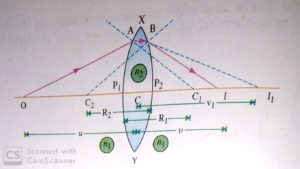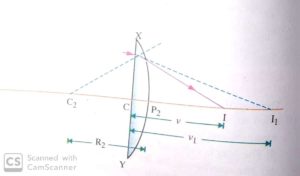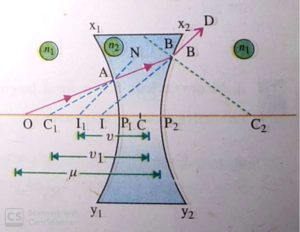In this article, we will be learning about the Lens Maker Formula which is also included in the syllabus of Physics in Class 12. We will first begin with the Definition, followed by some assumptions that are made to derive the lens maker formula. We will then go through the Sign Conventions used. Then we will derive Lens Maker Formula: derive lens maker formula for convex lenses and lens maker formula for concave lenses with diagrams.
The formula giving the relation between the focal length (f) of the lens, the refractive index of the material of the lens (n) and the radii of curvature of its surface (R1 & R2) is known as Lens maker formula.
The manufacturers of the lenses use this relation to design the lens of a given focal length and hence it is called so.
Assumptions made to derive Lens maker formula
(i) The lens is thin and all the distances are measured from the optical centre of the lens.
(ii) The aperture of the lens is small.
(iii) The object is a point object and lies on the principal axis.
(iv) The angle made by incident ray and refracted ray with the principal axis are small.
New Cartesian Sign Conventions
(i) All the distances are measured from the optical centre of the lens.
(ii) Distances measured in the direction of the propagation of incident light are taken as positive while the distances measured in the direction opposite to the direction of propagation of incident light are taken as negative.
Derivation of Lens Maker Formula for Convex lens

Consider a lens made of a material of absolute refractive index n2. This lens is placed in a medium of absolute refractive index n1 (n1 < n2 ). This lens is bounded by two spherical refracting surfaces XP1Y and XP2Y. C1 and C2 be their centres of curvature and R1 and R2 be their radii of curvature respectively. C is the optical centre of the lens.
STEP I. Refraction at Surface XP1Y

Let O be a point object lying in the rarer medium on the principal axis of the refracting surface XP1Y. The incident ray OA after refraction at A bends towards the normal AC1 and meets the principal axis at I1 if the second surface XP2Y were not present. So I1 is the real image of the object O.
Since object lies in the rarer medium, so we have
– n1/u + n2/v1 = n2 – n1/R1 ……(i)
STEP 2. Refraction at Surface XP2Y

In fact, the ray AB refracted by the first surface XP1Y is refracted at B by the second surface XP2Y and it finally meets the principal axis at I. The point I1 acts as a virtual object placed in the denser medium for the spherical surface XP2Y. Now it is the situation, when the object is placed in the denser medium and image is formed in the rarer medium.
– n2/v1 + n1/v= n1 – n2/R2
or – n2/v1 + n1/v= – (n2 – n1)/R2
– n1/u + n1/v = (n2 – n1) (1/R1 – 1/R2)
or – 1/u + 1/v = (n2/n1 – 1) (1/R1 – 1/R2)
But n2/n1 = n, relative refractive index of the lens w.r.t. the rarer medium.
– 1/u + 1/v = (n – 1) (1/R1 – 1/R2)
If the object is at infinity, the image is formed at the principal focus of the lens.
Hence eqn. (vii) becomes
– 1/∞ + 1/f = (n – 1) (1/R1 – 1/R2)
or 1/f = (n – 1) (1/R1 – 1/R2)
Eqn. (viii) represents Lens maker formula.
Derivation of Lens Maker Formula for Concave Lens

Let a concave lens have two spherical surfaces X1P1Y1 and X2P2Y2 having radius of curvature as R1 and R2 respectively.
STEP I. Refraction at X1P1Y1
Let O be a point object lying in the rarer medium on the principal axis of the refracting surface X1P1Y1. The incident ray OA after refraction at A bends towards the normal NC1 and travel along AB. It appears to come from point I1 if the second surface X2P2Y2 were not present. So I1 is the virtual image of the object O.
So object lies in the rarer med1um, so we have
– n1/u + n2/v = n2 – n1/R
Here v = v1 and R = R1
∴ – n1/u + n2/v1 = n2 – n1/R1 ……(i)
STEP 2. Refraction at X2P2Y2
Ray AB inside the lens will stiffer another refraction at surface X2P2Y2. After refracting from surface X2P2Y2, the ray travels along BD and appears to come from the point I. So, I is the final virtual image of the object O. Point I1 acts as the virtual object placed in the denser medium for the surface X2P2Y2.
– n2/u + n1/v = n1 – n2/R
Here u = v1 and R = R2
∴ – n2/v1 + n1/v = n2 – n1/- R2
STEP 3. Adding Eqs. (i) and (ii), we get
– n1/u + n1/v = (n2 – n1) (1/R1 – 1/R2)
or 1/v – 1/u = (n2/n1 – 1) (1/R1 – 1/R2)
or 1/v – 1/u = (n – 1) (1/R1 – 1/R2) (n2/n1 = n)
For u = infinity, the image is formed at principal focus so v = f (the focal length of the lens).
Then 1/f – 1/∞ = (n – 1) (1/R1 – 1/R2)
or 1/f = (n – 1) (1/R1 – 1/R2)